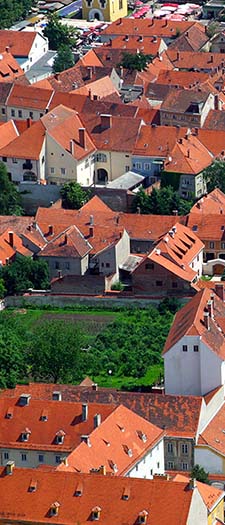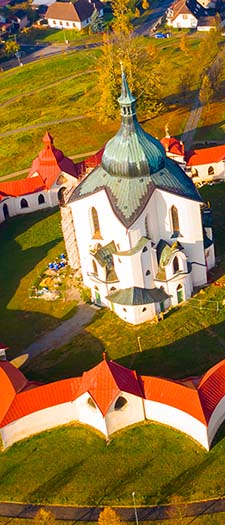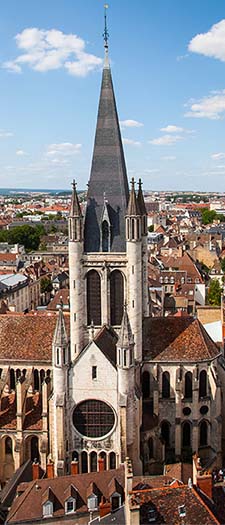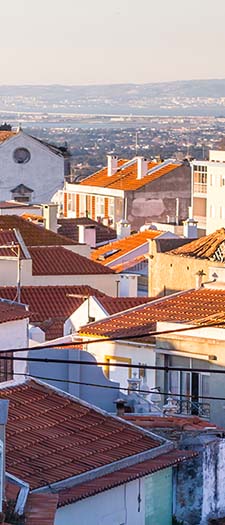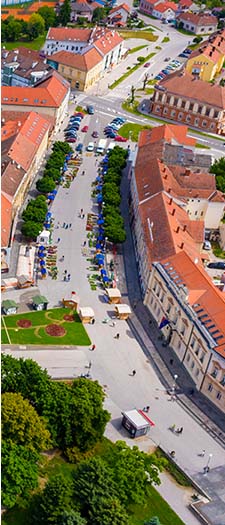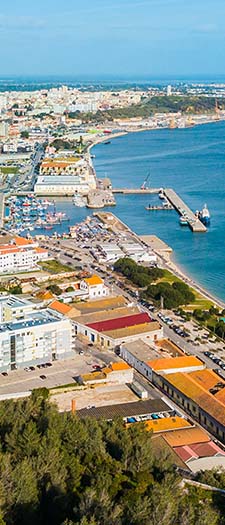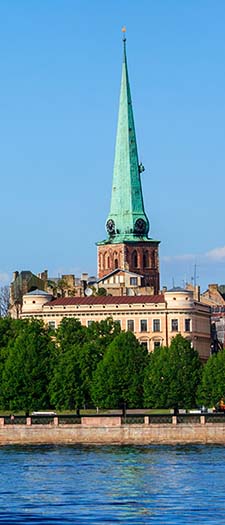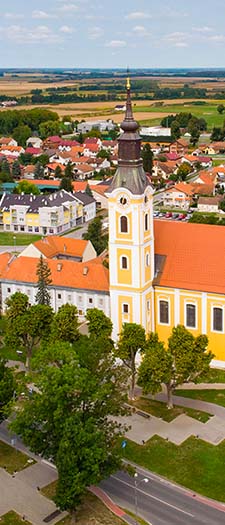Cities
EUCityCalc supports cities in leading the transition towards climate neutrality bringing together a broad range of cities in different stages in their transition, but united in the effort to attain climate neutrality.
The EU City Calculator empowers pilot cities to develop scientifically robust, detailed and actionable policy scenarios and transition pathways towards climate neutrality, in line with the 2050 EU targets and underpinned by a cross-sectoral and territorial approach to decarbonisation.
With the EU City Calculator at its core, the EUCityCalc project aims at supporting 10 pilot cities in leading the transition towards climate neutrality, developing scientifically robust, detailed and actionable policy scenarios and transition pathways in line with the 2050 EU targets. Furthermore, the project brings together a broad range of cities in different stages in their transition, but united in the effort to attain climate neutrality.

Dijon Métropole, France
N. of inhabitants: 260000 (Metropolis)
Short description of the city
Dijon is located in Eastern France and is the capital of Burgundy Franche Comté Region. It is an attractive metropolis composed of 23 cities, the biggest of which (Dijon) counts more than 155,000 inhabitants. Famous for its culinary specialties, Dijon has always been a wine-growing town whereas the vineyards of Burgundy, being more than 2,000 years old, are included in the World Heritage List of UNESCO.
Dijon metropolis has developed at the crossroads of major European North-South and East-West communication axes. In this respect, it exerts its influence on a vast area covering the three largest French regions: the Paris basin, the Rhône-Alpes region and the metropolises of Alsace-Lorraine. The territory has indisputable advantages in terms of accessibility by transport networks.
Towards climate neutrality – the vision and the main implemented policies
Dijon Metropolis is highly committed to achieving the necessary energy transition. In 2017 the renewable energy produced within DM increased by 83% since 2010 reaching 380 GWh/year. In 2018, Dijon signed the new Covenant of Mayors for Climate and Energy and committed to reducing GHG emissions by 40% before 2030. In 2019, Dijon voted for new local climate and energy efficiency policies. This allowed to increase from 59% of the share of RES to 69%, and preserve existing carbon sinks that store 31,000 tCO2e (Decision of Dijon Metropole n°6 of 26/09/2019).
Main climate goals of the city
Dijon has set itself the goal of being carbon neutral by 2050. The city has been implementing an ambitious policy to combat climate change since 2008. In these past years, Dijon has involved local actors to co-construct this strategy and has mobilized national and European funds and initiatives to help the city achieve carbon neutrality. The selection of Dijon in several H2020 initiatives like REPONSE is a clear sign of the city’s determination to reach the targets. The climate objective is central to Dijon’s municipal policy. Dijon Métropole reduced its greenhouse gas emissions by 19.2% between 2010 and 2018. Moreover, it has very likely exceeded -20% in 2020, a target set in 2009 as part of the Covenant of Mayors. Building on this momentum, Dijon Métropole now has the political will to accelerate its energy transition, which is well underway, and is putting in place the necessary policies and tools to achieve its objectives by relying on its ongoing solutions while continuing to innovate. New targets had been set for 2050. Given the emergency, policies will be intensified so that these targets are reached by 2030.
Key projects in which the city is involved

Koprivnica, Croatia
N. of inhabitants: 28,666
Short description of the city
Koprivnica is a city located in the northern part of Croatia, a small, modern town that has a high standard of living. It is the economic, educational, scientific, and cultural center of the region. Koprivnica is a pioneer of e-mobility in Croatia and a frontrunner in the sustainable development of urban and rural areas in North Croatia. Koprivnica constantly works hard towards greener solutions in pursuit oftoward energetic independence in the general goal of reaching carbon neutrality by 2050. Strategic development objectives are based on encouraging energy efficiency and use of RES, reduction of CO2 emissions towards carbon neutrality and development and application of innovations.
Towards climate neutrality – the vision and the main implemented policies
City of Koprivnica is a signatory of Covenant of Mayors initiative and signed a commitment for 2020 objectives in 2010 and committed to the new objectives until 2030 in 2019. Long term vision of Koprivnica is to reduce CO2 emissions by 2030 by a minimum of 55 % and 80 % by 2050. Implementation of all defined measures within SECAP Koprivnica by 2030 will result in a decrease in CO2 emissions by 57.01 % compared to the base year. Of the total CO2 savings, the building sector can save up to 56.32 %, the transport sector 58.12 % and the public lightning sector for 57,66 %.
Main climate goals of the city
Koprivnica, Varaždin and Virovitica share a vision of creating resilient and decarbonized municipalities where citizens have access to safe, sustainable, competitive, and affordable energy. To realize the vision, cities will fulfill their mission of promoting and supporting voluntary activities to adapt to climate change and to move towards low-emission society. Unfortunately, the consequences of climate change cannot be avoided, but through expertise at the national and local levels, efforts are being made to act in harmony with nature in order to mitigate the impact of climate change and create resilient communities through adaptation.
Key projects in which the city is involved
- https://rea-sjever.hr/projekti/c-track-50/
- https://koprivnica.hr/eu-projekti/green-aura/
- https://rea-sjever.hr/projekti/edufootprint-plus/
- https://koprivnica.hr/eu-projekti/dynaxibility4ce/
- https://koprivnica.hr/eu-projekti/low-carb/
- https://rea-sjever.hr/projekti/prominent-med/
- https://koprivnica.hr/eu-projekti/e-mob/
Other
Varaždin, Koprivnica and Virovitica were finalists for best cities and towns. In the category ‘Champion of EU funds’, Virovitica triumphed as the best and most successful in the field of using EU funds. Varaždin and Koprivnica were finalists in the category ‘Economy – large-sized town/city’.

Varazdin, Croatia
N. of inhabitants: 43,999
Short description of the city
VARAŽDIN – The City of Varaždin situated in the north-west of Croatia is among another cultural, educational and economic center of the county whose main focus is on innovations and informational technology in terms of future prosperity. Varaždin plays key role in energy transition and innovative technology deployment as there are a number of companies focused on developing innovative solutions that will facilitate sustainable energy and climate projects implementation.
Towards climate neutrality – the vision and the main implemented policies
The city of Varaždin is a signatory of Covenant of Mayors initiative and signed a commitment for 2020 objectives in 2012 and committed to the new objectives until 2030 in 2020. Long term vision of Varaždin is to reduce CO2 emissions by 2030 by a minimum of 55 % and 80 % by 2050. Implementation of all defined measures within SECAP Varaždin by 2030 will result in a decrease of CO2 emissions by 55.62 % compared to the base year. Of the total CO2 savings, the building sector can save up to 60.10 %, the transport sector 46.06 % and the public lightning sector for 57,66 %.
Main climate goals of the city
Koprivnica, Varaždin and Virovitica share a vision of creating resilient and decarbonized municipalities where citizens have access to safe, sustainable, competitive, and affordable energy. To realize the vision, cities will fulfill their mission of promoting and supporting voluntary activities to adapt to climate change and to move towards a low-emission society. Unfortunately, the consequences of climate change cannot be avoided, but through expertise at the national and local levels, efforts are being made to act in harmony with nature in order to mitigate the impact of climate change and create resilient communities through adaptation.
Key projects in which the city is involved
- https://rea-sjever.hr/projekti/c-track-50/
- https://rea-sjever.hr/projekti/social-green-nastavak/
- https://varazdin.hr/pravilnim-primjerom-ucimo-zastititi-okolis-promo/
- https://varazdin.hr/urbact-iii-come/
Other
Varaždin, Koprivnica and Virovitica were finalists for best cities and towns. In the category ‘Champion of EU funds’, Virovitica triumphed as the best and most successful in the field of using EU funds. Varaždin and Koprivnica were finalists in the category ‘Economy – large-sized town/city’.

Virovitica, Croatia
N. of inhabitants: 19,266
Short description of the city
The city of Virovitica is located in the north-east of Croatia. Virovitica actively invests in the RES and EE measures for years. The results regarding energy retrofitting projects, energy efficiency, as well as the energy production from RES are putting this cultural, political and sports center in rank with other, bigger cities leaning toward carbon neutrality and sustainable development. City of Virovitica second year in a row took first place in the category of the most co-foundation from the EU funds on the national level. This good leadership contributes to well-being and better living standard of the citizens, while at the same time contributing to the goals set up with SECAPs.
Towards climate neutrality – the vision and the main implemented policies
The city of Virovitica is a signatory of the Covenant of Mayors initiative and signed a commitment for new 2030 objectives in 2020. Long term vision of Virovitica is to reduce CO2 emissions by 2030 by a minimum of 55 % and 80 % by 2050. Implementation of all defined measures within SECAP Virovitica by 2030 will result in a decrease in CO2 emissions by 56.76 % compared to the base year. Of the total CO2 savings, the building sector can save up to 57.01 %, the transport sector 56.27 % and the public lightning sector for 57,66 %.
Main climate goals of the city
Koprivnica, Varaždin and Virovitica share a vision of creating resilient and decarbonized municipalities where citizens have access to safe, sustainable, competitive, and affordable energy. To realize the vision, cities will fulfill their mission of promoting and supporting voluntary activities to adapt to climate change and to move towards low-emission society. Unfortunately, the consequences of climate change cannot be avoided, but through expertise at the national and local levels, efforts are being made to act in harmony with nature in order to mitigate the impact of climate change and create resilient communities through adaptation.
Key projects in which the city is involved
Other
Varaždin, Koprivnica and Virovitica were finalists for best cities and towns. In the category ‘Champion of EU funds’, Virovitica triumphed as the best and most successful in the field of using EU funds. Varaždin and Koprivnica were finalists in the category ‘Economy – large-sized town/city’.

Sesimbra, Portugal
N. of inhabitants: 52,394
Short description of the city
Located in the southwest of the Setúbal Peninsula, Sesimbra municipality is bounded on the west by the Atlantic Ocean. Its coastline, with multiple landscapes, stretches to the Serra da Arrábida, a mountainous biogenetic reserve that covers the municipalities of Palmela, Setúbal and Sesimbra,
The Sado river estuary, the Arrábida mountains ending up on sandy beaches along the coast, the Cape Espichel, the Albufeira lagoon and the Meco beach are part of the Sesimbra’s natural landscape, contributing for its touristic importance in the Lisbon Metropolitan Area. Fishing, tourism, construction materials and natural resources are driving factors of its economy.
Towards climate neutrality – the vision and the main implemented policies
Sesimbra joined the Covenant of Mayors in 2019 and committed to set long-term targets to achieve climate neutrality by 2050.
The Sustainable Energy and Climate Action Plan is being elaborated with the support of ENA and involving citizens, businesses, private and public entities in the definition of realistic objectives according to the vision of a just and clean energy transition in a climate adapted and resilient community. Sesimbra’s involvement in the PLAAC-Arrábida, EnerNetMob, SISMA Plus and EUCityCalc projects is being very important for the definition of energy efficiency, renewables and sustainable mobility objectives.
Main climate goals of the city
Sesimbra is elaborating its Sustainable Energy and Climate Action Plan, taking into account the 2030 Energy and Climate National Plan for attaining carbon neutrality in 2050 (Reduction of GHG emissions in 2050 by -85% to -90% compared to 2005), namelly:
- Reduction of -45% to -55% until 2030 in GHG emissions (compared to 2005 levels)
- At least 35% energy efficiency (reduction in primary energy consumption without non-energy uses)
- At least 47% of the renewable energy share
- At least 20% of the share of renewable energy in the transport sector
Key projects in which the city is involved
Among the ongoing or completed projects for attaining the territory sustainability, we emphasize:
- Sustainable Energy and Climate Action Plan
- Electromobility Plan for the Arrábida Region
- Energy observatory implemented by ENA
- Energy production with bio-residues
- PLAAC-Arrábida
- Public lighting
- Energy efficiency in swimming pools and buildings
Other

Palmela, Portugal
N. of inhabitants: 68,856
Short description of the city
Located in Lisbon Metropolitan Area, Palmela is the largest municipality of the Setúbal Peninsula. Despite its proximity to Lisbon, it reconciles a strong industrial development with preservation of many rural characteristics.
Covering a vast distric of the Tagus and Sado river basins, Palmela is a transition territory between three of the most important national protected areas – Arrábida Natural Park, Sado and Tagus Estuaries’ Natural Reserves.
The biophysical structure areas cover almost half of Palmela’s territory and include the National Ecological and Agricultural Reserves, Forest Areas and areas classified as National Interest Sites (Natura 2000 Network).
Towards climate neutrality – the vision and the main implemented policies
Palmela signed up for the Covenant of Mayors in 2009, being the first municipality in the Arrábida territory to elaborate and implement the Sustainable Energy Action Plan, with a final version submitted at the end of 2020. Presently it is pondering signing up for the Covenant of Mayors for Climate and Energy. It is also working on the adaptation of the 2030 Energy and Climate National Plan for carbon neutrality in 2050. It is involved in several projects aiming at increasing energy efficiency, as well as promoting electromobility and raising awareness of the community such as PLAAC-Arrábida, EnerNetMob, SISMA Plus and EUCityCalc.
Main climate goals of the city
Palmela finalised the implementation and monitoring of its Sustainable Energy Action Plan. Presently is working on the 2030 Energy and Climate National Plan for attaining carbon neutrality in 2050 (Reduction of GHG emissions in 2050 by -85% to -90% compared to 2005), building up a set of objectives on:
- Reduction of -45% to -55% until 2030 in GHG emissions (compared to 2005 levels)
- At least 35% energy efficiency (reduction in primary energy consumption without non-energy uses)
- At least 47% of the renewable energy share
- At least 20% of the share of renewable energy in the transport sector
Key projects in which the city is involved
Among the ongoing or completed projects for attaining territory sustainability, we emphasize:
- Eco-families
- Eco-companies
- Sustainable Energy Action Plan of Palmela
- Electromobility Plan for the Arrábida Region
- Energy observatory implemented by ENA
- Sustainable Energy measures
- Guide for Sustainable Buildings
- PLAAC-Arrábida
- Public lighting
- Energy efficiency in swimming pools
Other

Setúbal, Portugal
N. of inhabitants: 123,519
Short description of the city
Setúbal diverges between land and sea, urban and natural, tradition and modernity. The municipality and district capital possesses major service centres, combining an important agricultural activity with a strong industrial component, tourism, cement manufacturing and commerce, holding the third largest sea port in the country.
Located south of the Tagus River, Setúbal municipality is limited to the west by the Atlantic Ocean, with a vast natural heritage of which highlights the Serra da Arrábida, holding the protected areas of the Arrábida Natural Park and the Sado Estuary Natural Reserve.
Towards climate neutrality – the vision and the main implemented policies
Pursuing a sustainable development in economic, environmental and social dimensions, Setúbal subscribed the Covenant of Mayors in 2014 and upgraded its strategy in 2016 by joining the Covenant of Mayors for Climate and Energy.
By implementing its Energy and Climate Sustainability Action Plan based on know-how and best practices of BEACON, PLAAC-Arrábida, EnerNetMob, SISMA Plus and EUCityCalc projects, Setúbal aims at decreasing CO2 emissions by 40% until 2030. The main policies: increase of energy efficiency through the Energy Efficiency Plan (PEE); create carbon sinks in the territory; implement a Sustainable Mobility Plan; raise awareness and train citizens in the scope of climate sustainability.
Main climate goals of the city
Setúbal is working on the 2030 Energy and Climate National Plan for attaining carbon neutrality in 2050 (Reduction of GHG emissions in 2050 by -85% to -90% compared to 2005), having the following objectives:
- Reduction of -40% until 2030 in GHG emissions (compared to 2005 levels)
- At least 35% energy efficiency (reduction in primary energy consumption without non-energy uses)
- At least 47% of the renewable energy share
- At least 20% of the share of renewable energy in the transport sector
Key projects in which the city is involved
Among the 31 measures proposed in the Setúbal Sustainable Energy Plan, 24 are currently underway or have already been completed. Among the ongoing or completed projects for attaining the defined goals, we highlight:
- Green Seal – Environmental Quality Certificate of Setúbal Municipality
- Várzea Urban Park
- Environmental Good Practices Guide
- Setúbal Sustainable Mobility Plan/, with the projects:
- Transition Point, an energy literacy project implemented by ENA
- Beacon
- Energy observatory implemented by ENA
- PLAAC-Arrábida
- Public lighting
Other

Mantova, Italy
N. of inhabitants: 49,200
Short description of the city
Mantova is a small town and a Unesco World Heritage site located in one the most industrialized, highly populated and polluted plain of the entire UE (the Pianura Padana); it is located in the Mincio river valley surrounded by 3 artificial lakes. The processes related to past economic growth and the need for urban settlements have drained the natural capital and depleted the biodiversity, with negative repercussions on human health and quality of life. The City is deeply involved in multidisciplinary and shared urban regeneration, green policies for sustainable urban development and improvement of the quality of life.
Towards climate neutrality –the vision and the main implemented policies
Mantova was ranked the most liveable city in Italy in 2017. This does not, however, disguise the serious environmental problems faced due to a legacy of soil contamination and water pollution from the chemical industry since the 1960’s. The city works to define and implement a new model of sustainable urban development building on the value of its many assets developing a more integrated policy-making approach, working transversally across city departments and with increased public participation. The Sustainable Urban Mobility Action Plan, the Climate Strategy, the Carbon Neutrality network are the main policies adopted to reach the goal.
Main climate goals of the city
The city is working to become carbon neutral in 2050 experimenting mitigation and adaptation to climate change solutions in accordance with surrounding cities.
Key projects in which the city is involved

Žďár nad Sázavou, Czech Republic
N. of inhabitants: 20,153
Short description of the city
Žďár nad Sázavou is a middle-sized town located in the heart of the Czech Republic. The center of the Bohemian-Moravian Highland is appreciated for its nature and landscape. Its famous Pilgrimage Church of St. John of Nepomuk Church at the Zelena hora was included in the UNESCO Heritage List in 1994.
The city offers all types of civic amenities including sports facilities and high schools. Moreover, locals perceive the city as healthy and with a very low crime rate.
Most citizens work in the industry, while many others work in the nearby towns.
Towards climate neutrality –the vision and the main implemented policies
According to SECAP, the aim is to reduce CO2 emissions by at least 40 % by 2030 compared to 2000. Till the year 2019, the emissions were reduced by 37,94 %. The main implemented policy is the central district heat source use. It supplies over 90 % of the heat consumed in the city. The heat distribution grid is managed by a municipal-owned company. The evolvement of the grid depends on the municipal leaders only. The municipal buildings’ energy consumption is monitored by the energy management system based on the ISO 50001 standard.
Main climate goals of the city
To reduce CO2 emissions by at least 40 % by 2030 compared to year 2000.
Key projects in which the city is involved
A new heat source for the municipal heating distribution grid. The current source is based on coal and should be closed in the near future. The new source was built based on gas. The new-fashioned source should generate both heat and electricity. However, the gas supply may suffer disruption because of the war in Ukraine.

Riga, Latvia
N. of inhabitants:
Short description of the city
Founded in 1201, Riga is the capital and the largest city of Latvia with a territory of 307 km2. Being home to 605 802 residents (beginning of 2022), it is also the largest city in the Baltic states. Thanks to its central geographical position, it is recognized as the European metropolis at the crossroads of Eastern and Northern Europe. Riga is a UNESCO World Heritage site with one of the world’s richest collections of Art Nouveau on the grand boulevards and attractive historical architecture in the suburbs and Old Town. However, the Historic Centre of Riga and its protection zone including almost 20% of the city area make the achievement of climate goals even more challenging due to specific regulations of maintaining the historical heritage.
Towards climate neutrality – the vision and the main implemented policies
In early 2020, the Latvian government adopted two major energy and climate planning documents setting ambitious long-term goals for energy transition until 2030 and 2050. The key goals of Riga SECAP-2030 have been set following the EU and National energy and climate objectives. To achieve the vision – Riga: Climate-Neutral City by 2050 – the Municipality has committed to achieving the status of a climate neutral municipality already by 2030, ensuring that municipal institutions are as sustainable as possible. It aims to have climate-neutral and resilient municipal infrastructure to the risks caused by climate change. Moreover, recently Riga was approved as one of the first 100 Climate-neutral and Smart European cities.
Main climate goals of the city
The key goals of Riga SECAP-2030 have been set following the EU and National energy and climate objectives. Specific goals of Riga SECAP-2030 are related to the vision of a climate-neutral and resilient municipality already by 2030 and include the following measurable targets to be achieved by 2030:
- Climate-neutral municipal buildings using 100% RES as the heat energy source;
- Decrease of energy consumption in municipal buildings – 20% reduction compared to 2020;
- Decrease energy consumption in centralised district heating – 20% reduction compared to 2020;
- Comprehensive energy renovation of multi-apartment residential housing – 2.000 buildings refurbished;
- Climate-neutral municipal lighting and traffic lights infrastructure using 100% RES;
- Climate-neutral municipal transportation fleet: zero-emission vehicles using 100% RES, and other targets.
Moreover, the vision of a climate-neutral and resilient municipality includes such goals as a gradual shift from private cars to more sustainable transport modes, significant improvements in the field of waste management, ensuring the sustainability of the city’s natural capital, achieving better environmental quality, shift to circular economy model, and many others.
Key projects in which the city is involved
- AmsTErdam – BiLbao cItizen drivEn smaRt cities – ATELIER; Horizon 2020, Grant Agreement ID: 864374 (ongoing). Development of a “Bold City Vision 2050” for guiding the city’s energy & climate transition challenges (incl. sustainable transport). Piloting a Positive Energy District concept in Riga city.
- Artificial Intelligence for Next Generation Energy – I-NERGY; Horizon 2020, Grant Agreement ID: 101016508 (ongoing). De-risking energy efficiency investments in multi-apartment housing using artificial intelligence solutions: collection and processing data from smart meters, and applying machine learning algorithms in order to better predict energy consumption and calculate and monitor the energy savings achieved.
- Integrated solutions for energy refurbishment – INNOVATE; Horizon 2020, Grant Agreement ID: 754112 (completed in 2020). Development and roll-out of integrated energy efficiency service packages. Establishment of One-Stop-Shop for energy renovation in Riga city.
- circUlaR buildinG citiEs – URGE; URBACT III, (ongoing). Accelerating the transition to the circular economy in the construction sector – a major consumer of raw materials. URGE brings together cities and their stakeholders to inspire and learn from each other in developing their integrated urban policy.

